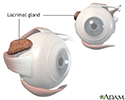Lacrimal gland tumor
A lacrimal gland tumor is a tumor in 1 of the glands that produces tears. The lacrimal gland is located under the outer part of each eyebrow. Lacrimal gland tumors can be harmless ( benign ) or cancerous ( malignant ). About half of lacrimal gland tumors are benign.
Tumor
A tumor is an abnormal growth of body tissue. Tumors can be cancerous (malignant) or noncancerous (benign).
Benign
"Benign" refers to a condition, tumor, or growth that is not cancerous. This means that it does not spread to other parts of the body. It does not ...

Malignant
The term "malignancy" refers to the presence of cancerous cells that have the ability to spread to other sites in the body (metastasize) or to invade...

Symptoms
Symptoms may include:
- Double vision
- Fullness in 1 eyelid or the side of the face
- Pain
Exams and Tests
You may first be examined by an eye doctor (ophthalmologist). You may then be evaluated by a head and neck doctor (otolaryngologist, or ENT), or a doctor who specializes in problems with the bony eye socket (orbit).
Tests most often include a CT or MRI scan .
CT
A computed tomography (CT) scan of the orbit is an imaging method. It uses x-rays to create detailed pictures of the eye sockets (orbits), eyes and ...

MRI scan
A magnetic resonance imaging (MRI) scan is an imaging test that uses powerful magnets and radio waves to create pictures of the body. It does not us...

Treatment
Most lacrimal gland tumors will need to be removed with surgery. Cancerous tumors may need other treatment too, such as radiation or chemotherapy.
Outlook (Prognosis)
The outlook is most often excellent for noncancerous growths. The outlook for cancer depends on the type of cancer and stage at which it is discovered.
References
Hayek B, Esmali B. Lacrimal gland tumors. In: Tasman W, Jaeger EA, eds. Duane's Ophthalmology . 16th ed. Philadelphia, PA: Lippincott Williams & Wilkins; 2013:chap 40.
Karcioglu ZA, Haik BG. Eye, orbit, and adnexal structures. In: Niederhuber JE, Armitage JO, Doroshow JH, Kastan MB, Tepper JE, eds. Abeloff's Clinical Oncology . 5th ed. Philadelphia, PA: Elsevier Churchill Livingstone; 2014:chap 67
Melicher-Larson JS, Jones YJ, Nerad JA. Secondary orbital tumors. In: Tasman W, Jaeger EA, eds. Duane's Ophthalmology . 16th ed. Philadelphia, PA: Lippincott Williams & Wilkins; 2013:chap 46.
Yanoff M, Cameron D. Diseases of the visual system. In: Goldman L, Schafer AI, eds. Goldman's Cecil Medicine . 25th ed. Philadelphia, PA: Elsevier Saunders; 2016:chap 423.
-
Lacrimal gland anatomy - illustration
The lacrimal gland is located within the orbit above the lateral end of the eye. It continually releases fluid which cleanses and protects the eye's surface as it lubricates and moistens it. These lacrimal secretions are commonly known as tears.
Lacrimal gland anatomy
illustration
-
Lacrimal gland anatomy - illustration
The lacrimal gland is located within the orbit above the lateral end of the eye. It continually releases fluid which cleanses and protects the eye's surface as it lubricates and moistens it. These lacrimal secretions are commonly known as tears.
Lacrimal gland anatomy
illustration
Review Date: 8/11/2015
Reviewed By: Franklin W. Lusby, MD, ophthalmologist, Lusby Vision Institute, La Jolla, CA. Also reviewed by David Zieve, MD, MHA, Isla Ogilvie, PhD, and the A.D.A.M. Editorial team.

